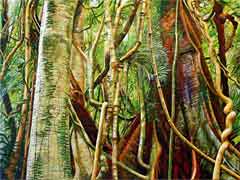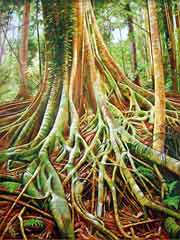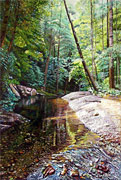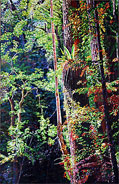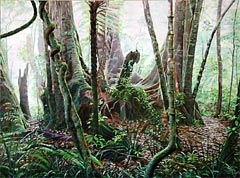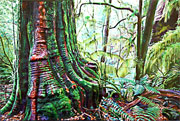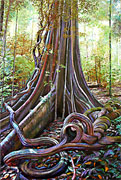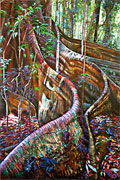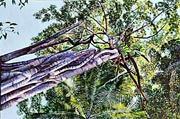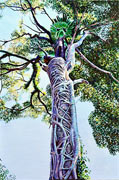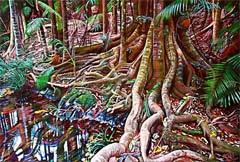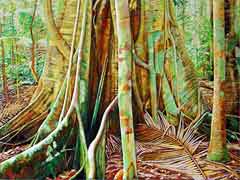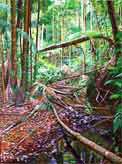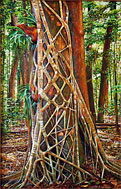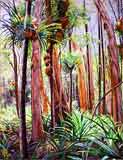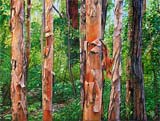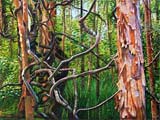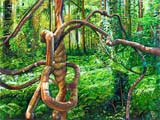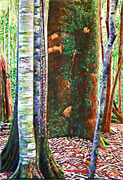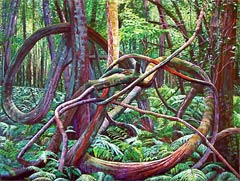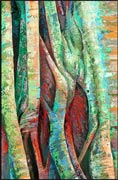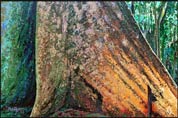Rainforest series
Much lauded by lovers of science and nature, at first glance it seems a wonder that the rainforest has been so infrequently depicted by Australian landscape artists. Early colonial painters wandered the wet forests, the Australian impressionists delighted in the icons of old stately eucalypts and pastoral scenes. Other artistic forefathers explored ghostly towns, mountain terrains and the broad central desert. Most avoided the dark humidity of the rainforest; perhaps it seemed less distinctively Australian, or perhaps it was simply too inhospitable for the gentle artist traipsing the countryside with a backpack of paints, a rickety easel and a couple of canvases.
When digging beneath the over-friendly ticks and leeches or brushing past the grasping reach of stinging trees and lawyer vines there is a unique beauty; as there is when timidly taking a long, slow breath in the close, almost claustrophobic space. Whether they are in sub tropical or cool temperate climates the Australian rainforests have distinctive features, offering up a rich diversity of subject matter. From the tangle of lianas and vines to the broad sculptural beauty of buttress roots, the vivid colours are generated by the interplay of filtered light on brilliant flowers and fronds. Textures mesmerise at each accidental brush or careful touch. Capturing this environment brings unique challenges; foreground noise such as vines, ferns and shrubs, a canopy which filters and limits light, and a dense concentration of mass vegetation.
Broad landscapes are a comfortable beauty, easy to admire, relaxing when captured on a living room wall. It can take a moment to adjust to the contrast between the classical broad landscape and the rainforest vista. Enjoying claustrophobia is perhaps more demanding, moving from the vast to the intimate, then looking through that into the menacing beauty of the rainforest has its own reward.
Rainforest in Myopic Landscapes paintings
In Myopic Landscapes paintings the unique rainforest landscape feature and traits are capture using colour and shape; the sense of tangled depth is captured through sculptured features, and small sense of the tactile component conveyed through textural relief.
Dorrigo's sub tropical rainforest
Dorrigo National Park is one of the best known localities to experience sub tropical rainforest in NSW. The combination of escarpment topography, basaltic soils, and high rainfall has produced large areas of protected rainforest. Areas of the rainforest are easily accessible through formed walks from the visitors centre and the Never Never Picnic Area.
Dorrigo Rainforest, Rooted in Dorrigo and Rosewood Creek all come from this area:
The vegetative density and species diversity of sub tropical rainforests is shown in Dorrigo Rainforest. This mass of vegetation limits your viewpoint to the foreground and can produce a feeling of claustrophobia. Trees in rainforests compete strongly for nutrients so roots systems are critical. These roots are often close to the soil surface so as to access nutrients quickly as they are released form decomposing litter. Rooted in Dorrigo depicts this distinctive network of roots and buttresses of one the larger rainforest trees. Viewpoints and light are very limited within rainforests. Only in creek lines, as shown in Rosewood Creek, can light penetrate to the ground and a more panoramic view be seen. The light contrast of these localities can produce dramatic effects.
Cool temperate rainforests
The Border Ranges National Park has the largest area of protected rainforest in NSW, especially in combination with the adjacent Lamington National Park in Queensland. There are sub tropical, cool temperate, and warm temperate rainforest in this area.
Cool temperate rainforests are remnants of the old Gondwanaland flora and are characterised by Antarctic Beech (Notofagus moorei). Bird's Nest Fern depicts the distinctive colourful new leaves of Antarctic Beech in contrast to the epiphyte Bird's Nest Fern fronds. Cool temperate rainforests are restricted in NSW to protected areas on high elevation escarpments, adjacent to the coast. These high rainfall areas receive a significant portion of their precipitation as fog and mist. Antarctic Beech often forms copses, that is, new stems grow from the base of an older tree that has collapsed. Both the misty atmosphere and the copse habit are shown in Antarctic Beech Copse.
Another area of cool temperate rainforest can be found at New England National Park at Point Lookout:
New England Squatter depicts a misty scene of the distinctive base of an ancient, moss covered Antarctic Beech amongst trees draped with the epiphyte Spanish Moss.
Murray Scrub
Some of the characteristic remnants of rainforest in NSW State Forests were protected as Floral Reserves. Murray Scrub Floral Reserve in the Richmond Range State Forest preserved a significant area of magnificent sub tropical rainforest. This has now become a key feature of Toonumbar National Park.
Serpent in the Garden and Dragon Drapery depict elaborate sculptural forms of two key features of sub-tropical rainforest, root buttresses and lianas:
Light competition is savage in sub tropical rainforests so the tallest trees, or emergents, have the competitive advantage. This advantage is exploited by other species that utilise the emergent tree surface as a substrate for growth and access to light. Thus when you look up through the rainforest canopy you can see a diverse number of plant species growing on the emergent trees, mostly as epiphytes ferns, staghorns, and orchids. Strangler Figs often germinate on the trunks of other trees and slowly suffocate their host by sending down roots that encapsulate the host trunk and sending up stems and leaves that out compete the host. Thus you get a single tree with two distinctively different leaf shapes and bark textures. These features seen looking vertically up into the rainforest canopy are depicted in the Emergent Canopy Trilogy. Looking up in rainforests means being able to see the sky and light, both rare things viewed from the rainforest floor. Emergent Canopy Trilogy: 1 and Emergent Canopy Trilogy: 2 depict emergent trees co-opted by Strangler Figs that also have numerous epiphytes. Emergent Canopy Trilogy: 3 shows a Red Cedar with an understorey of Bangalow Palms. The palm fronds produce complex patterns in light and shadow.
The vertical viewpoint of the Emergent Canopy Trilogy produces curious perspectives. These paintings should be viewed high on a wall to reproduce this perspective.
Sherwood Nature Reserve, near Woolgoolga, has a small area of sub-tropical rainforest adjacent to Woolgoolga Creek. Bangalow Palms form the understorey beside this creek.
Bangalow Octopus shows exposed buttress roots surrounded by palm trunks.
Bruxner Park
Bruxner Park was Floral Reserve within Orara East State Forest that has now been incorporated into the new Ulidarra National Park. This is the closest area of protected sub-tropical rainforest to Coffs Harbour. Phil spent considerable time in this area whilst completing his master's degree.
Bruxner Park Rainforest 1 shows the juxtaposition of buttress roots and palm trunks while Bruxner Park Rainforest 2 shows a rainforest creek with opening cause by a wind-fall.
Littoral rainforest
Littoral rainforests occur in protected areas adjacent to the coast or estuaries and usually have lower species diversity than sub-tropical rainforests. In NSW, littoral rainforests are now rare due to coastal development but two key surviving areas are at Bundagen and Iluka.
Bundagen Strangler, Strangler's Embrace, and Staghorns and Paperbarks are all from Bundagen Floral Reserve which is now part of Bongil Bongil National Park:
Strangler Figs are of particular interest to me because they typify the extreme adaptation found in rainforest species. The growth habit of Strangler Figs includes germinating on, and then colonising an existing tree that becomes encapsulated and finally killed by suffocation, is both grotesque and inspired. The process of growing roots downward over the host tree trunk produces forms reminiscent animal circulatory systems and other anatomical metaphors. Once the host has died and rotted away, the remaining structure of the Strangler Fig can be quiet strange as seen in Bundagen Strangler - a weird sculpture to survival and adaptation.
Littoral rainforests often merge with other estuarine communities such as Paperbark (Melaleuca spp) forests. Staghorns and Paperbarks and Paperbark Entanglement Quartet depict these transition areas where rainforest components such as lianas and staghorn epiphytes mix with Paperbark trees:
The distinctive bark of the vertical Paperbarks trunks contrast with the sinuous lianas that invade these stands are shown in the four panels of Paperbark Entanglement Quartet, which captures an area in the North Coast Regional Botanic Garden, Coffs Harbour NSW.
Warm temperate rainforest
Warm temperate rainforests differ from sub-tropical rainforests by having a less complex structure and fewer tree species. These rainforests occur on less fertile soils or sites with lower rainfall or less suitable climate. Two tree species characteristic of the northern NSW warm temperate rainforests are Coachwood (Ceratopetalum apetalum) and Brushbox (Tristania conferta). Coachwood, in particular, has a very distinctive pale bark with greenish blue markings. This contrasts with the rougher, scaly bark of Brushbox shown in Coachwood Brushbox from Cascade National Park.
As you travel south along eastern NSW, the occurrence of sub-tropical rainforest becomes more restricted and warm temperate rainforest becomes more common in protected gullies where water and nutrients are more plentiful:
Liana Sigil depicts one of these rainforest gullies where massive water vines have produced strange cursive forms strewn through the Lilly Pilly canopy.
Big Scrub Forest Reverse
The Big Scrub Forest Reverse is located north of Lismore NSW:
Strangler Fig and Giant Buttress are of this area, they are early works of Phil's, and the start of this series.
Find out more about Phil's art:


